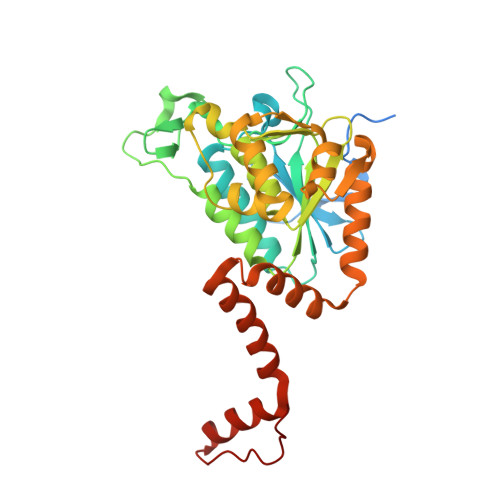Ligand-dependent active-site closure revealed in the crystal structure of Mycobacterium tuberculosis MenB complexed with product analogues
Song, H., Sung, H.P., Tse, Y.S., Jiang, M., Guo, Z.H.(2014) Acta Crystallogr D Biol Crystallogr 70: 2959-2969
- PubMed: 25372686
- DOI: https://doi.org/10.1107/S1399004714019440
- Primary Citation of Related Structures:
4QII, 4QIJ - PubMed Abstract:
1,4-Dihydroxy-2-naphthoyl coenzyme A (DHNA-CoA) synthase catalyzes an essential intramolecular Claisen condensation in menaquinone biosynthesis and is an important target for the development of new antibiotics. This enzyme in Mycobacterium tuberculosis is cofactor-free and is classified as a type II DHNA-CoA synthase, differing from type I enzymes, which rely on exogenous bicarbonate for catalysis. Its crystal structures in complex with product analogues have been determined at high resolution to reveal ligand-dependent structural changes, which include the ordering of a 27-residue active-site loop (amino acids 107-133) and the reorientation of the carboxy-terminal helix (amino acids 289-301) that forms part of the active site from the opposing subunit across the trimer-trimer interface. These structural changes result in closure of the active site to the bulk solution, which is likely to take place through an induced-fit mechanism, similar to that observed for type I DHNA-CoA synthases. These findings demonstrate that the ligand-dependent conformational changes are a conserved feature of all DHNA-CoA synthases, providing new insights into the catalytic mechanism of this essential tubercular enzyme.
Organizational Affiliation:
Department of Chemistry and State Key Laboratory of Molecular Neuroscience, The Hong Kong University of Science and Technology, Clear Water Bay, Kowloon, Hong Kong SAR, People's Republic of China.
















